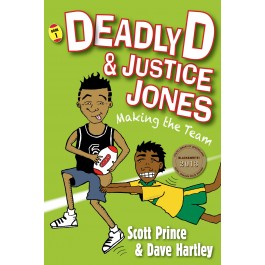 I’m probably the only person in Australia who’s never heard of the Broncos, much less its star player Scott Prince, but I reckon that makes me the best person in Australia to review his new book, written for children. Who could be less biased, eh? Even though I was very proud that my son played representative rugby as a teenager, I know nothing about the game (or indeed any other kind of football). So, for me, Deadly D and Justice Jones, Book 1: Making the Team has to work as a story. For my students (who mostly follow soccer) this book will need to have a compelling plot, credible characters that they can relate to, and an engaging style.
I’m probably the only person in Australia who’s never heard of the Broncos, much less its star player Scott Prince, but I reckon that makes me the best person in Australia to review his new book, written for children. Who could be less biased, eh? Even though I was very proud that my son played representative rugby as a teenager, I know nothing about the game (or indeed any other kind of football). So, for me, Deadly D and Justice Jones, Book 1: Making the Team has to work as a story. For my students (who mostly follow soccer) this book will need to have a compelling plot, credible characters that they can relate to, and an engaging style.
Well, you’ll be pleased to hear that it does. Written specifically to engage active sports-mad boys, Deadly D and Justice Jones in written as a straightforward chronological first-person narrative, related by 11-year-old Dylan Conlan, who has to move from Mt Isa to Brisbane because his mother has a new job. On his very first day at his new school he encounters the School Bully, Jared Knutz and his thuglike father, terrorising the principal because he’s had the temerity to discipline Jared for throwing rocks at a teacher’s car. By afternoon, he’s seen him bullying a smaller Kiwi boy, Justice jones. By page 33 it dawns on the reader, reluctant or otherwise, that young Dylan is no ordinary boy: when angry he explodes out of his clothes like the Incredible Hulk – and he promptly chucks Jared off the jetty and into the water, leaving his gang to scarper as fast as they can.
In the best tradition of superheroes, Dylan has to keep this transformation a secret. His mother has taught him anger management techniques, but Jared provokes him again when they’re on a school excursion to visit a Broncos’ training day. And when Dylan explodes onto the ground, the Broncos are impressed, and invite him to join the team! Of course there is a slight problem that Dylan has to get mad in order to morph into Deadly D, but Justice manages to come up with some hilarious ways of achieving it. So Dylan is able to make amends for losing a game for his team back in Mt Isa, and not only that, Jared gets his comeuppance too, (though I suspect that he will make a comeback in Book 2).
While not heavy-handed about it, the book also contrasts the Waitangi treaty that is commemorated every year in New Zealand, with the unresolved reconciliation process here in Australia. (If constitutional recognition is something that you care about too, visit Recognise and find out more.)
A Kalkadoon man from Mt Isa, Scott Prince co-authored Deadly D and Justice Jones – Making the Team with primary school deputy principal Dave Hartley of the Barunggam people from the Darling Downs/Chinchilla region. They wrote it over four years and then submitted it for a State Library of Queensland’s 2013 black&write! Indigenous Writing Fellowship. They didn’t win, but the judges were so impressed that they created the kuril dhagun prize as a one-off, and the deal included publication of the story by indigenous publishing house, Magabala Books.
The book is 122 pages long and includes half-a-dozen B&W drawings by Dave Hartley. It’s suitable for independent readers, has brief (and funny) ‘deadly notes (a.k.a. a glossary) at the back, author bios, and some information about the black&write! project which aims to foster indigenous writing.
There are teacher notes at Magabala Books.
Availability






